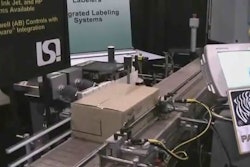Many suppliers offer sophisticated solutions to authentication and track-and-trace. Each supplier continues to stress that no one solution is the answer to the dilemma. Serialization seems to edge out other solutions as a universal panacea.
What I'm still not hearing is how do we achieve this level of global standardization or “harmonization” as it is referred to here in the EU? Which organization will establish these standards?
Where is all this massive amount of data going to be stored? What cyber security measures will be taken to insure that today's counterfeiters don't become tomorrow's computer hackers?
All of these issues are left unaddressed. Also, I still don't hear authentication measures being offered to doctors, nurses, or moms and dads. Most solutions seem to offer financial protection for suppliers against diversion or fraud, and legal protection for suppliers, again, regarding lawsuits.
With the advent of smartphone technology, I would think we would be hearing more about putting the patient in the authentication driver's seat. Was it here and I missed it?
Compliance making strides
Where I do hear the patient being included into the discussions is the area of compliance and adherence. And not only the patient, but the long-forgotten package designers are being invited to the table to address patient's needs.
Sue Rockhill, business development director for Burgopack in the U.K., talked candidly about one study where a woman with breast cancer said, “I already know I'm different. I already know I'm sick. Why do I have to be reminded every time I take my medicine?”
Indeed, most medicine packaging is boring, lacks interesting color or shape and comes off as institutional as the walls of a hospital (http://bit.ly/HCP005). One possible answer here would be a sleek, discreet, beautiful package resembling a cosmetic case in feminine colors.
Non-compliance is a major obstacle to a patient's health and a major drain on any nation's healthcare costs. Rockhill cited research from the World Health Organization where half of those suffering from a chronic condition fail to take their medicine at the right time in the right dose.
Major barriers to successful outcomes are the fact that drug regimens have become more complex, leaflets and packaging are often confusing or hard to read (or are discarded or separated from drug), fear of medication and possible side effects, and poor communication by healthcare providers who do not have enough time to explain properly.
Even when healthcare providers do take the time, patients often forget. Rockhill cited a study where 100% of the patients polled believed they had heard directions and were taking the proper dose at the proper time, when in fact only 20% were following instructions properly.
Forty percent of respondents threw away leaflets or packaging so they had no reference point when questions came up. An astonishing 90% said they need a package they can travel with—citing the growing need for convenience and an emphasis on lifestyle!
We need to make the package part of the treatment. Yes, it may be more expensive in the beginning, but weigh those costs with the expense associated with multiple visits to the hospital, and these packs begin to make sense.
Rockhill suggested more use of bolder colors, attaching leaflets that are easier to use and fold back up again. “No senior citizen wants to be practicing origami with their leaflet.”
Another speaker talked about triangle and oval-shaped containers winning out in surveys—yet most remain round.
Sustainability “largely absent”
One major trend in packaging, sustainability, is practically non-existent at this event except for one of the winning packages (http://bit.ly/HCP007). In a report on trends driving pharmaceutical packaging, the speaker purposefully left out sustainability.
I did not get to visit every stand, but one exception to the rule was Chesapeake, which is introducing a beautiful carton stock I believe is made from the leftovers after sugar cane has been processed. The sample they showed me was beautiful, organic looking and feeling, but unfortunately all the accompanying information was in French. More on this release when we get the English.
There was an overall theme here that stockholders are demanding that pharmaceutical companies do a better job purchasing materials and running more efficient lines. Why sustainable practices were not focused on to a greater degree, I do not understand.
-By Jim Chrzan, Publisher
What I'm still not hearing is how do we achieve this level of global standardization or “harmonization” as it is referred to here in the EU? Which organization will establish these standards?
Where is all this massive amount of data going to be stored? What cyber security measures will be taken to insure that today's counterfeiters don't become tomorrow's computer hackers?
All of these issues are left unaddressed. Also, I still don't hear authentication measures being offered to doctors, nurses, or moms and dads. Most solutions seem to offer financial protection for suppliers against diversion or fraud, and legal protection for suppliers, again, regarding lawsuits.
With the advent of smartphone technology, I would think we would be hearing more about putting the patient in the authentication driver's seat. Was it here and I missed it?
Compliance making strides
Where I do hear the patient being included into the discussions is the area of compliance and adherence. And not only the patient, but the long-forgotten package designers are being invited to the table to address patient's needs.
Sue Rockhill, business development director for Burgopack in the U.K., talked candidly about one study where a woman with breast cancer said, “I already know I'm different. I already know I'm sick. Why do I have to be reminded every time I take my medicine?”
Indeed, most medicine packaging is boring, lacks interesting color or shape and comes off as institutional as the walls of a hospital (http://bit.ly/HCP005). One possible answer here would be a sleek, discreet, beautiful package resembling a cosmetic case in feminine colors.
Non-compliance is a major obstacle to a patient's health and a major drain on any nation's healthcare costs. Rockhill cited research from the World Health Organization where half of those suffering from a chronic condition fail to take their medicine at the right time in the right dose.
Major barriers to successful outcomes are the fact that drug regimens have become more complex, leaflets and packaging are often confusing or hard to read (or are discarded or separated from drug), fear of medication and possible side effects, and poor communication by healthcare providers who do not have enough time to explain properly.
Even when healthcare providers do take the time, patients often forget. Rockhill cited a study where 100% of the patients polled believed they had heard directions and were taking the proper dose at the proper time, when in fact only 20% were following instructions properly.
Forty percent of respondents threw away leaflets or packaging so they had no reference point when questions came up. An astonishing 90% said they need a package they can travel with—citing the growing need for convenience and an emphasis on lifestyle!
We need to make the package part of the treatment. Yes, it may be more expensive in the beginning, but weigh those costs with the expense associated with multiple visits to the hospital, and these packs begin to make sense.
Rockhill suggested more use of bolder colors, attaching leaflets that are easier to use and fold back up again. “No senior citizen wants to be practicing origami with their leaflet.”
Another speaker talked about triangle and oval-shaped containers winning out in surveys—yet most remain round.
Sustainability “largely absent”
One major trend in packaging, sustainability, is practically non-existent at this event except for one of the winning packages (http://bit.ly/HCP007). In a report on trends driving pharmaceutical packaging, the speaker purposefully left out sustainability.
I did not get to visit every stand, but one exception to the rule was Chesapeake, which is introducing a beautiful carton stock I believe is made from the leftovers after sugar cane has been processed. The sample they showed me was beautiful, organic looking and feeling, but unfortunately all the accompanying information was in French. More on this release when we get the English.
There was an overall theme here that stockholders are demanding that pharmaceutical companies do a better job purchasing materials and running more efficient lines. Why sustainable practices were not focused on to a greater degree, I do not understand.
-By Jim Chrzan, Publisher





















